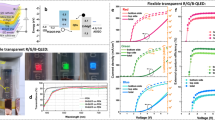Abstract
In this work, we propose that indium-tin-oxide (ITO)-free flexible hybrid white organic/inorganic light illuminated device application has a potential for next-generation flexible display. The process involves conventional blue planar organic light-emitting diodes as light source and quantum dot (QD) color conversion plate. Semitransparent anode electrode is used in light-emitting diodes, which has effective micro-cavity phenomenon, instead of ITO that is a conventional transparent conductive oxide of display area. QD color conversion plate is used according to the optimized QD size in color rendering, which has improved energy transfer property, by control of wavelength and QD thickness for proper realization of QD plates through reduced QD aggregation.





Similar content being viewed by others
References
D’Andrade BW, Thompson ME, Forrest S (2002) Controlling exciton diffusion in multilayer white phosphorescent organic light emitting devices. Adv Mater 14(2):147–151
So F, Kido J, Burrows P (2008) Organic light-emitting devices for solid-state lighting. MRS Bull 33(7):663–669
Gather MC, Köhnen A, Meerholz K (2011) White organic light-emitting diodes. Adv Mater 23(2):233–248
Jang E, Jun S, Jang H, Lim J, Kim B, Kim Y (2010) White-light-emitting diodes with quantum dot color converters for display backlights. Adv Mater 22(28):3076–3080
Jun S, Lee J, Jang E (2013) Highly luminescent and photostable quantum dot-silica monolith and its application to light-emitting diodes. ACS Nano 7(2):1472–1477
Min SY, Bang J, Park J, Lee CL, Lee S, Park JJ, Jeong U, Kim S, Lee TW (2014) Electrospun polymer/quantum dot composite fibers as down conversion phosphor layers for white light-emitting diodes. RSC Adv 4(23):11585–11589
Cho NK, Yu J, Kim YH, Kang SJ (2014) Effect of oxygen plasma treatment on CdSe/CdZnS quantum-dot light-emitting diodes. Jpn J Appl Phys 53(3):032101
Chen Z, Cotterell B, Wang W, Guenther E, Chua SJ (2001) A mechanical assessment of flexible optoelectronic devices. Thin Solid Films 394(1–2):202–206
Tak YH, Kim KB, Park HG, Lee KH, Lee JR (2002) Criteria for ITO thin film as the bottom electrode of an organic light emitting diode. Thin Solid Films 411(1):12–16
Alzoubi K, Hamasha M, Lu S, Sammakia B (2011) Bending fatigue study of sputtered ITO on flexible substrate. J Disp Technol 7(11):593–600
Lee KH, Kim JH, Jang HS, Do YR, Yang H (2014) Quantum-dot-based white lighting planar source through downconversion by blue electroluminescence. Opt Lett 39(5):1208–1211
Lee HW, Yang HJ, Yi JE, Kim YK, Ha Y (2015) Flexible white organic light-emitting diodes with a multi-metal electrode and a new combination of heteroleptic iridium compound. J Korean Phys Soc 66(1):133–136
Lee HW, Park J, Yang HJ, Lee SE, Lee SJ, Koo JR, Kim HJ, Yoon SS, Kim YK (2015) Optimization of semitransparent anode electrode for flexible green and red phosphorescent organic light-emitting diodes. J Nanosci Nanotechnol 15(3):2404–2408
Acknowledgments
This research was supported by Basic Science Research Program through the National Research Foundation of Korea (NRF) funded by the Ministry of Education (No. 2015R1A6A1A03031833) and the MSIP (Ministry of Science, ICT and Future Planning), Korea, under the ITRC (Information Technology Research Center) support program (IITP-2016-H8501-16-1009) supervised by the IITP (Institute for Information & communications Technology Promotion).
Author information
Authors and Affiliations
Corresponding authors
Additional information
H. W. Lee and H. S. Lee contributed equally to this work.
Rights and permissions
About this article
Cite this article
Lee, H.W., Lee, H.S., Lee, J.W. et al. ITO-free flexible hybrid white organic/inorganic light-emitting diodes using optimum color conversion quantum dot plates. Polym. Bull. 73, 2583–2591 (2016). https://doi.org/10.1007/s00289-016-1689-0
Received:
Revised:
Accepted:
Published:
Issue Date:
DOI: https://doi.org/10.1007/s00289-016-1689-0




